#spotted jewelweed
Photo




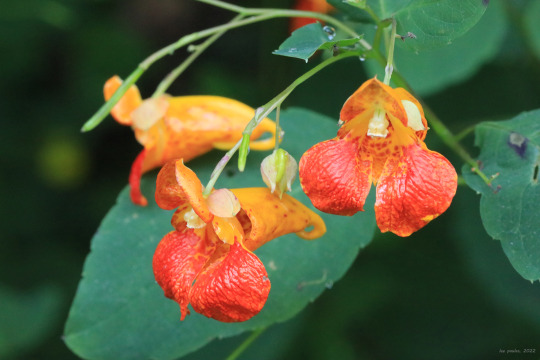
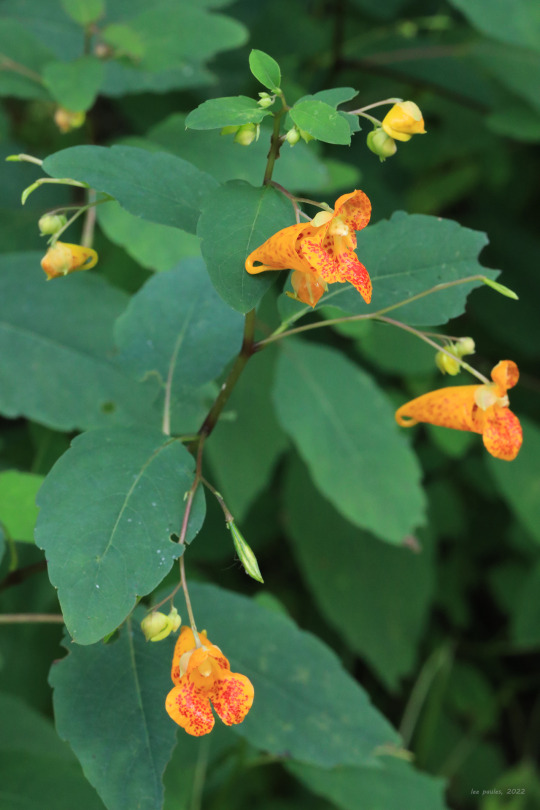
“Woodlot vagrant and trashy saint,
my love for you through decades grows,
Mortal skin rubbed with voodoo juice
Wards off ivy poison and chigger foes.
And from those fragile pods I pinch
a coiled-up confetti erupts,
Ah, those mundane seconds
of summer snooze
your joyful trick disrupts!
With fiery orange and yellow lips
Thirsty fliers you long seduce.
Delivered on frantic wings,
They burrow fast and draw deep sips.
Such a divine delirium
Your subtle perfume and nectar sow,
A succulent secret
Only you, me, and the bumblebee know."
Thus concludes another edition of my bad nature poetry, this time in honor of two of Appalachia’s most-beloved summer jewels (Impatiens pallida and I. capensis).
#appalachia#vandalia#west virginia#late summer#flora#wildflowers#impatiens capensis#orange jewelweed#orange balsam#spotted jewelweed#spotted touch-me-not#impatiens pallida#yellow jewelweed
69 notes
·
View notes
Text
Succulents Part 11--Wild Impatiens
Succulents are a wide variety of plants, spanning multiple orders. Some have succulent leaves while others have succulent stems. Cactuses are succulents, but not all succulents are cactuses. Defining what exactly makes a succulent is a little tricky. For example, cabbage leaves are considered by some to be succulent, but tulip and onion leaves apparently aren't.
All photos mine. Unedited.
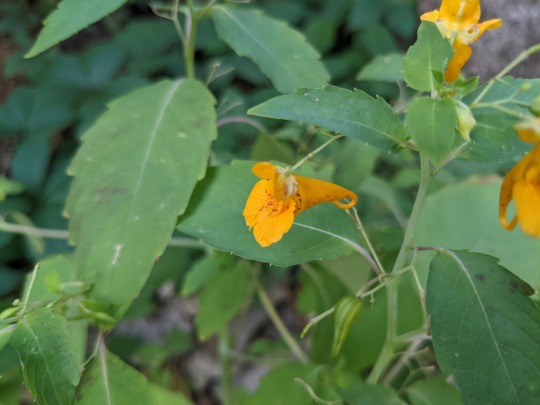






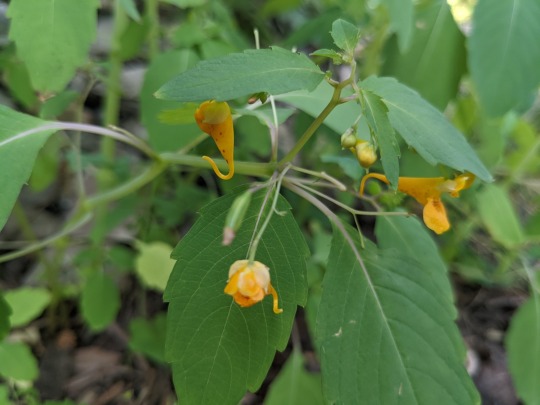
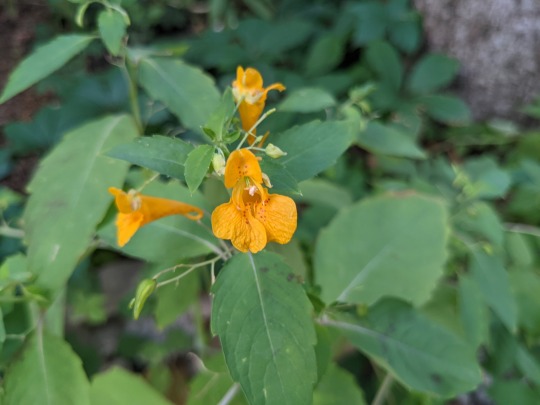
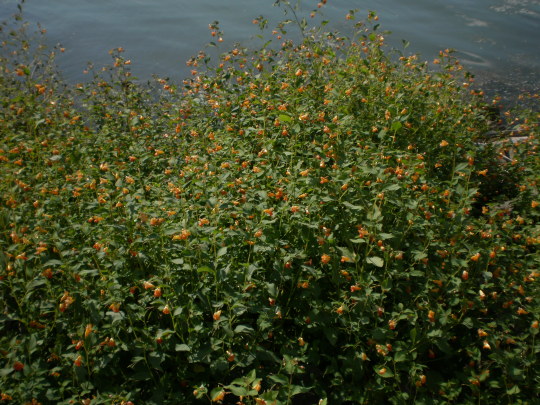
Did you know we have native Impatiens in Ontario, Canada? They're called jewelweed or touch-me-not. :) I have them in my garden and they can also be found in ravines and on shorelines in swampy areas. They like a lot of water. In the Niagara escarpment under the heavy canopy with the constant moisture? They'll grow on trees, out of rocks, wherever. They're native annuals, so they rely on reseeding, but do they ever reseed! The young shoots, thankfully, are edible cooked.
#succulent plants#stem succulents#succulents#flowers#my photos#photography#blackswallowtailbutterfly#Impatiens#wild impatiens#spotted touch-me-not#garden flowers#jewelweed#spotted jewelweed#Impatiens capensis#wildflowers#my garden#native North American plants
5 notes
·
View notes
Text
hmmm
i ate a plant I foraged, which the internet assured me was safe and "good in salads"
and now I seem to be a bit intoxicated
to be fair. coffee, even in small quanities, also makes me intoxicated, to the point of hallucination
so "safe for regular people" is not always "safe for salamander"
1 note
·
View note
Text


Impatiens capensis / Common Jewelweed at the North Carolina Botanical Gardens at the University of North Carolina at Chapel Hill in Chapel Hill, NC
#Impatiens capensis#Impatiens#Common Jewelweed#Orange Jewelweed#Spotted Jewelweed#Jewelweed#Spotted touch-me-not#Touch-me-not#Orange balsam#Balsaminaceae#Native plants#Native flowers#Nature photography#photographers on tumblr#Flowers#North Carolina Botanical Gardens#UNC#UNC-Chapel Hill#Chapel hill#Chapel hill NC#North Carolina
0 notes
Photo

Common Jewelweed
Impatiens capensis
Balsaminaceae
Photograph taken on August 12, 2022, along the Culham Trail, Mississauga, Ontario, Canada.
#wildflowers of southern ontario#Common Jewelweed#orange#jewelweed#spotted touch me not#touch me not#Impatiens capensis#Impatiens#Balsaminaceae#wildflowers#wildflower#flowers#flora#Culham Trail#Mississauga#Ontario#Canada
32 notes
·
View notes
Text
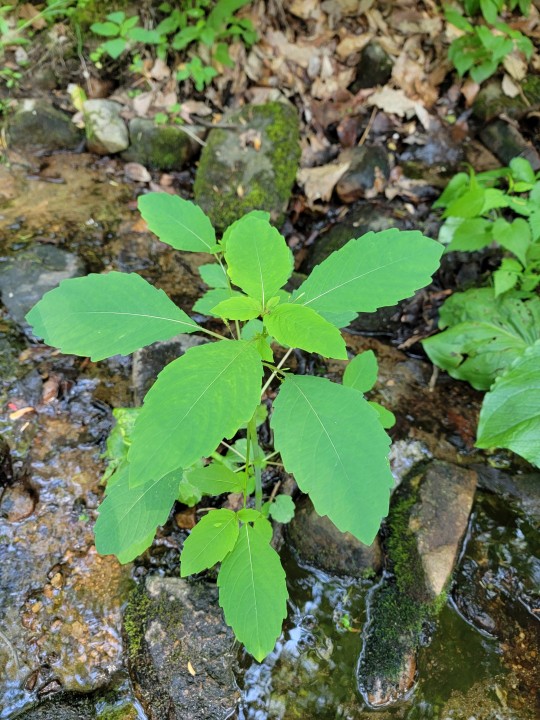
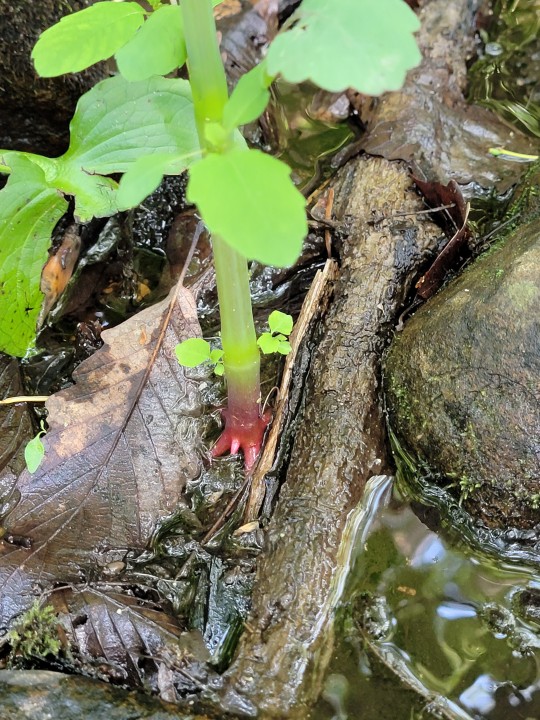
Orange Jewelweed growing out of the creek
#tumblr made editing posts incredibly annoying#spotted touch me not#orange jewelweed#a very effective poison ivy cure saved me the other day#impatiens capensis
3 notes
·
View notes
Text
Today I saw a liverwort for the first time!
I stood and watched a little heron perched on a tree and saw the most brilliant, jewel-like metallic blue and green dragonfly with wings the velvety black of the night sky.
The ironweed is blooming in rich royal purple, jewelweed in vivid orange, wingstem in bright sunny yellow, and cardinal flower in unbelievably vivid scarlet. Yellow goldenrod, magenta phlox, white Virginia clematis. Meadows and streambanks along the hiking trails are rainbowed with wildflowers. I appreciate wildflowers individually, but placed together their bright colors are a whole other tier or beauty.
There's a spot with a little meadow full of milkweed and the monarch butterflies have a breathless majesty that never goes away no matter how often I see one.
Walking home I heard a chorus of frogs and stopped for a while to listen to them.
Somehow I'm most excited by far about the liverwort.
1K notes
·
View notes
Text
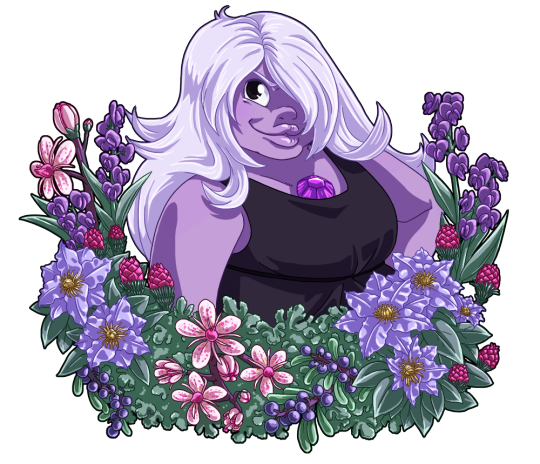

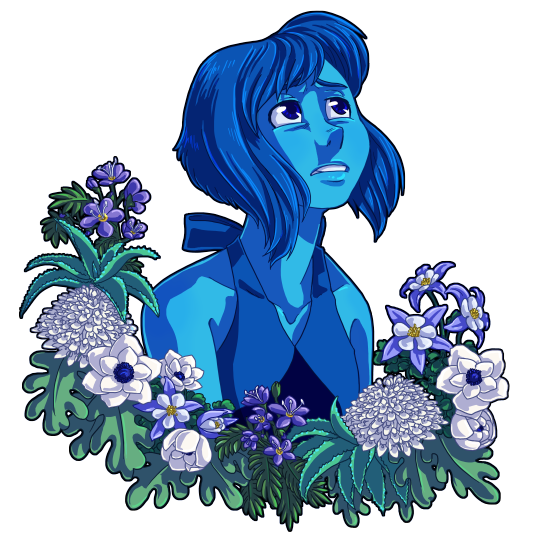
Repostober 27 - 2015
A small series of "Flower Language" (and leaves) portraits for some gems. I definitely did research (though couldn't tell you the sources anymore) and picked stuff out for all the major characters but only finished these three. Actually I found the notes doc I made, helpfully with reference pictures, so I can tell you what each of these ones are and what they mean! Under the cut.
Amethyst
Clematis (large light purple flowers) - Artifice/Trickery
Larch (pink and berry-looking) - Audacity
Sloe (blue berries) - Difficulty
London Pride (white with pink spots and middle) - Frivolity
Jewelweed (purple heart-shaped flowers) - Impatience
Coriander (background foliage, small ruffled leaves) - Hidden Worth
Peridot
Hollyhock (white, sort of trumpet shaped flowers) - Ambition
Euphorbia (small yellow flowers in clusters of three) - Persistence
Rose, yellow (...I think you know what a rose looks like.) - Jealousy
Clotbur (large three-pointed leaves) - Rudeness
Lapis Lazuli
Mourning Bride (large bunches of tiny white flowers) - "I have lost all"
Anemone (white star shaped flowers with deep blue middle) - Forsaken
Columbine, blue (Small white flower with long periwinkle outer petals) - Desertion
Jacob's Ladder (small purple flowers with long stamens) - "Come down"
Aloe vera (long thin spiked leaves) - Grief
Oak Leaves (wiggly? hopefully recognizable lol) - Bravery
I remember looking at a lot of different sources to get the kinds of meanings I was looking for. Not the usual stuff for bouquets that all mean varying levels of love and friendship and whatnot. So some of these could be kind of made up! You can never trust the internet. But I tried.
#art#repostober#artists on tumblr#drawing#digital art#fan art#fanart#portrait#series#flower language#Steven Universe#SU#Amethyst#Peridot#Lapis#Lapis Lazuli#nature#flowers#leaves#foliage#cartoon#Crystal Gems#cel shading#portrait series
72 notes
·
View notes
Note
I'm a city girl who's uncomfy around nature and bugs and I can't stop thinking about going on "nature walks" with you to get me more comfortable. Walks that all start innocent, where I marvel at your passion and knowledge, but that quickly turns into eyes lingering on how your ass looks in your jeans, my face barely hiding how badly I want one of us bent over a fallen log.
What a great idea ❤️ I know the best spots- nothing too backcountry, but not highly trafficked, either.
I'd walk slightly ahead of you, clearing the cobwebs that formed on the trail overnight, scanning for pretty things to show you. Maybe I'd spot some common jewelweed- guiding you to the orange flowers, our heads close as I point out the curved nectar spur. I'd notice movement a few feet from us and put one hand on your lower back (politely pretending to not hear the catch in your breath), turning you just slightly.
"You see it?" You'd shake your head, and I'd step behind you- my other hand settling on your waist, tilting you in the right direction. My voice would be low in your ear- "See that tree with the peeling bark, straight ahead? Follow the trunk down, and look in the jewelweed- those pretty orange flowers we were just looking at." I'd give your hips an encouraging squeeze when I hear you quietly, but excitedly, exclaim that you see it- a Ruby-throated hummingbird, flitting from flower to flower just a few feet from us. Feeling you settle back against me, the two of us just taking in the moment together.
Bonus: here's the common jewelweed (aka spotted touch-me-not) and Ruby-throated Hummingbird I ran into last week that inspired these thoughts 🏵️

#so sorry this took forever to answer!!#genuinely one of my favorite things is sharing my love of nature with others#so i took this in a pretty soft direction#but i need to put my fucking-against-a-tree toughts (of which there are many) into words soon#answered asks#bear talks#bear thoughts
12 notes
·
View notes
Text

Something simple I started back in June for Junicorn, but ended up abandoning for a bit. I revisited it this month and reworked the colors, I'm liking it a lot more now :,)
The flowers featured are Jewelweed (Impatiens capensis), also known as spotted touch-me-not. It's a native plant to North America/Turtle Island. Here in Atlanta I mostly see it growing in the swampy areas of creeks all throughout spring and summer! The flowers tend to show up well into the summer season. By now the plants have mostly died back due to the cold, but a few are still hanging on. Here's a link to the plant profile by the US Forest Service if you want to learn more: https://www.fs.usda.gov/wildflowers/plant-of-the-week/impatiens_capensis.shtml
#gatorskulls#unicorn#unicorn tag#fairy#fae#fairies#artists on tumblr#illustration#digital art#illustrator#digital drawing#queer art#queer artist#lgbt artist#clip studio paint#drawing tablet#art#artwork#original art#small artist#art nouveau
9 notes
·
View notes
Text
More flowers from my garden!
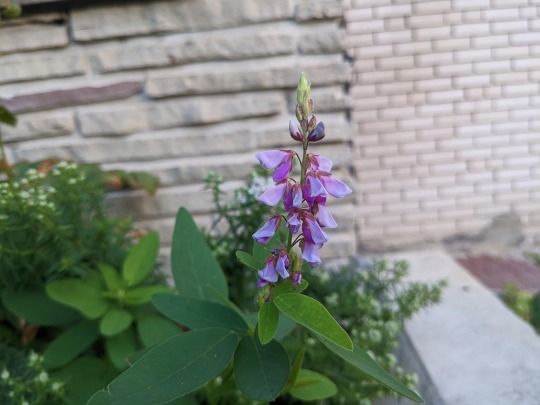
Desmodium canadense (showy tick trefoil)
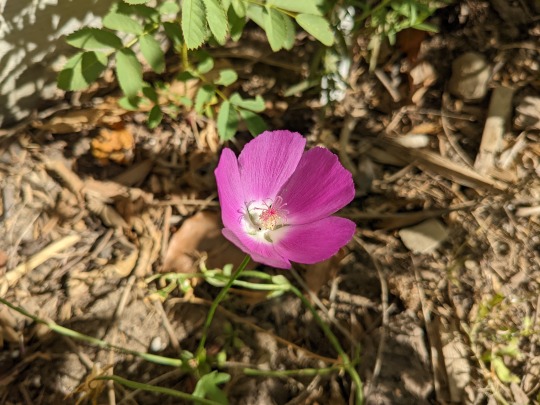
Callirhoe involucrata (purple poppymallow)

Pycnanthemum virginianum (Virginia mountain mint)
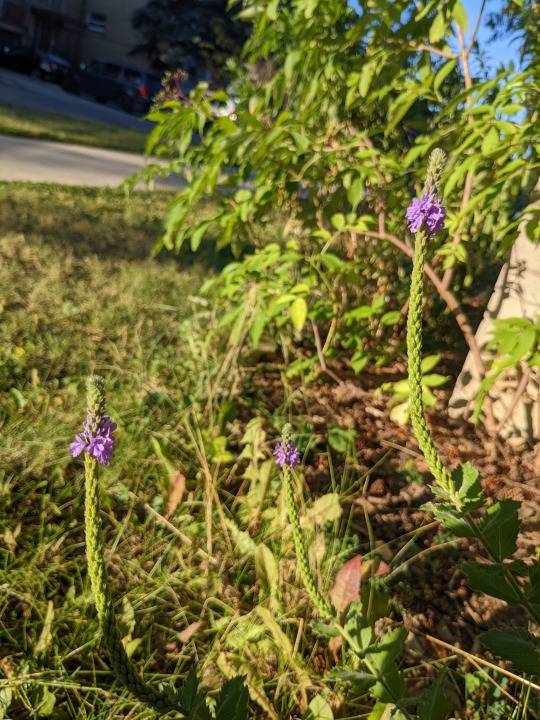
Verbena stricta (hoary vervain)

Eupatorium purpureum (sweet joe-pye-weed)

Monarda punctata (spotted beebalm)
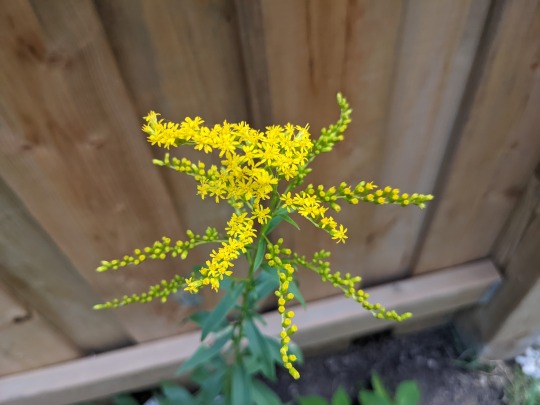
Solidago juncea (early goldenrod)
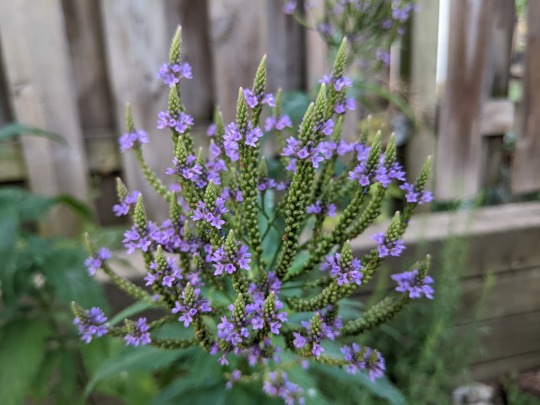
Verbena hastata (blue vervain)
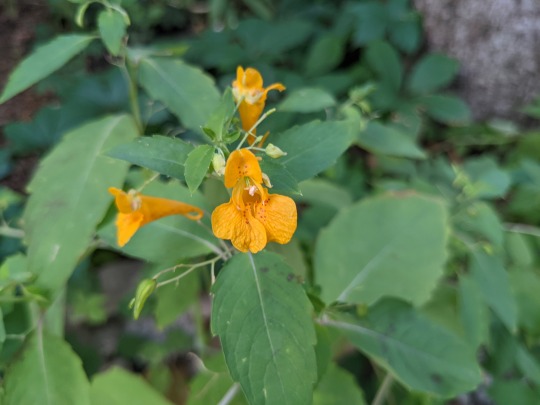
Impatiens capensis (spotted jewelweed)

Helianthus nuttallii (common tall sunflower)

Symphyotrichum ciliatum (fringed blue aster)
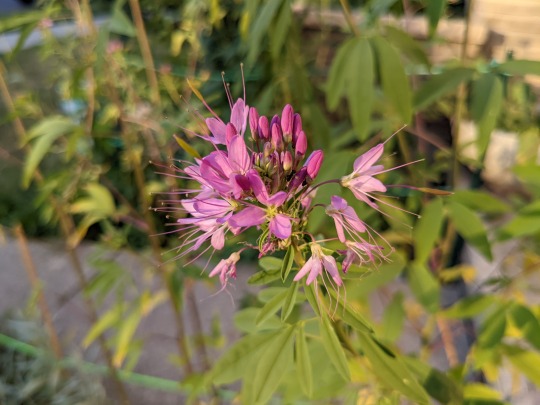
Cleome serrulata (Rocky Mountains bee plant)

Actaea racemosa (black snakeroot)

Helianthus pauciflorus (stiff sunflower)
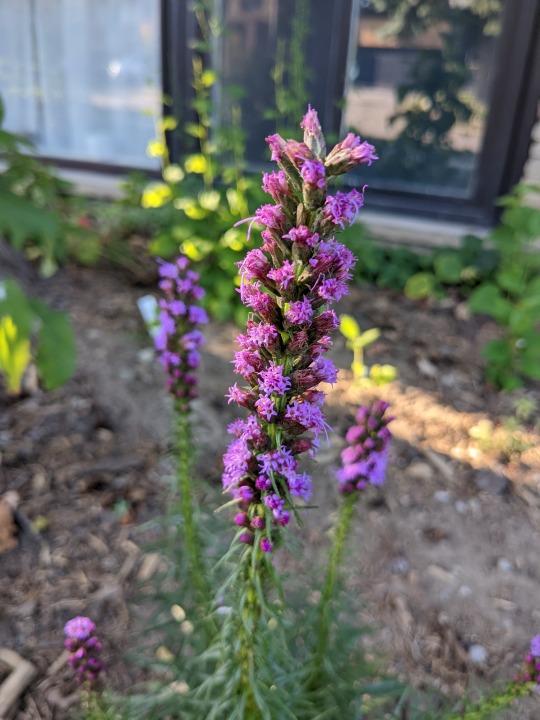
Liatris spicata (dense blazing star)

Hypericum punctatum (spotted St. John's wort)

Spiraea alba (meadowsweet)
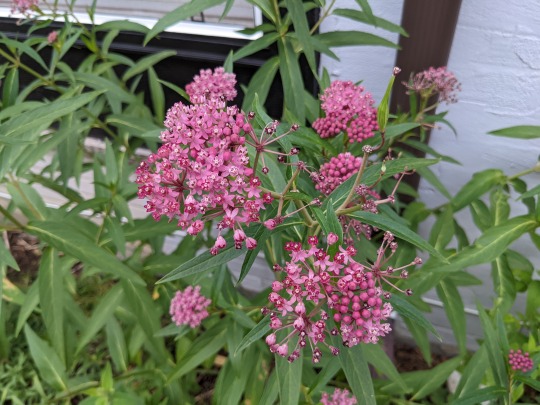
Asclepias incarnata (swamp milkweed)

Agastache foeniculum (anise hyssop)
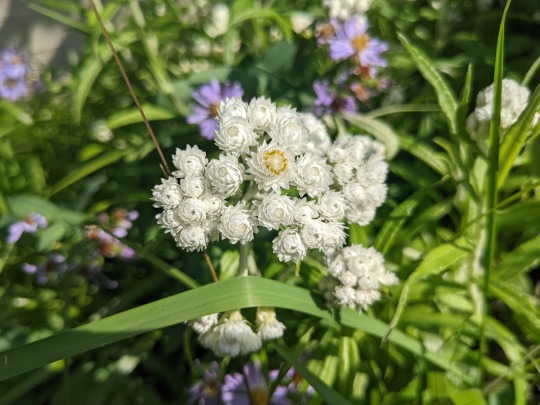
Anaphalis margaritacea (pearly everlasting)

Symphyotrichum laeve (smooth aster)
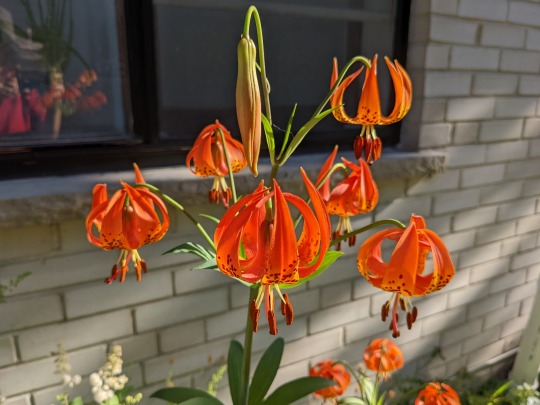
Lilium michiganense (Michigan lily)
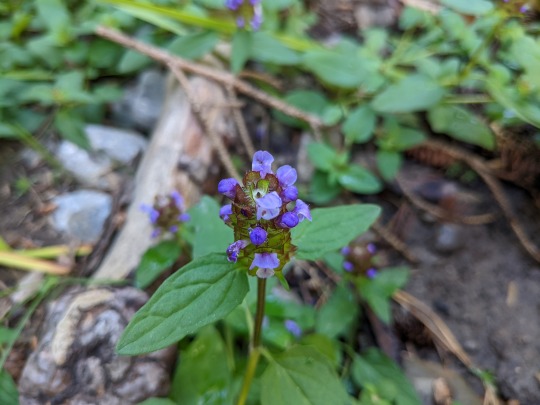
Prunella vulgaris ssp. vulgaris (common selfheal)

Symphyotrichum lanceolate (panicled aster)

Astragalus canadensis (Canada milk vetch)
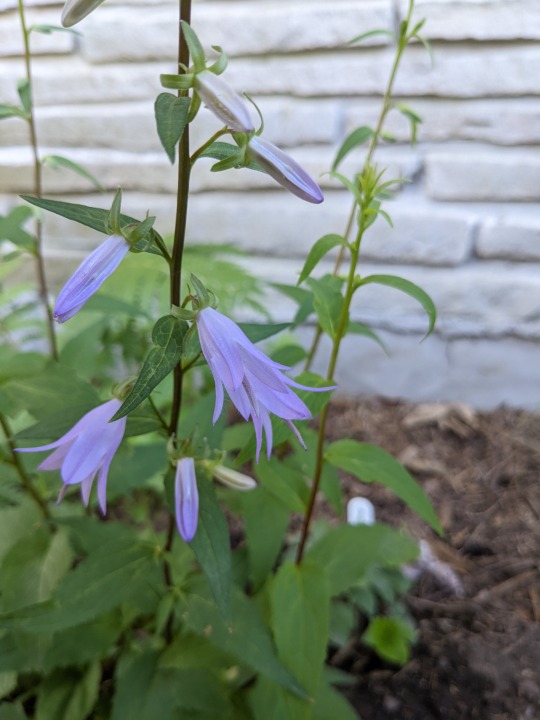
Campanulastrum americanum (marsh harebell)

Sambucus canadensis (common elderberry)

Mertensia paniculata (tall bluebells)
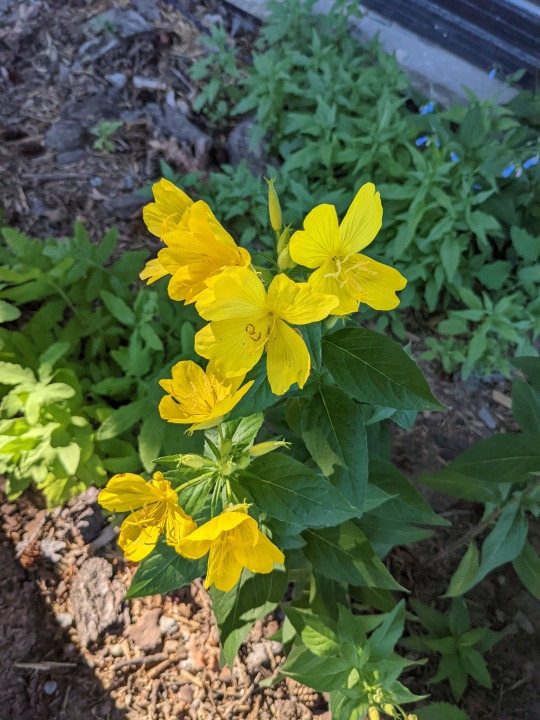
Oenothera fruticosa (narrow-leaved sundrops)

Lilium philadelphicum (wood lily)
And cut off again. lol
16 notes
·
View notes
Text
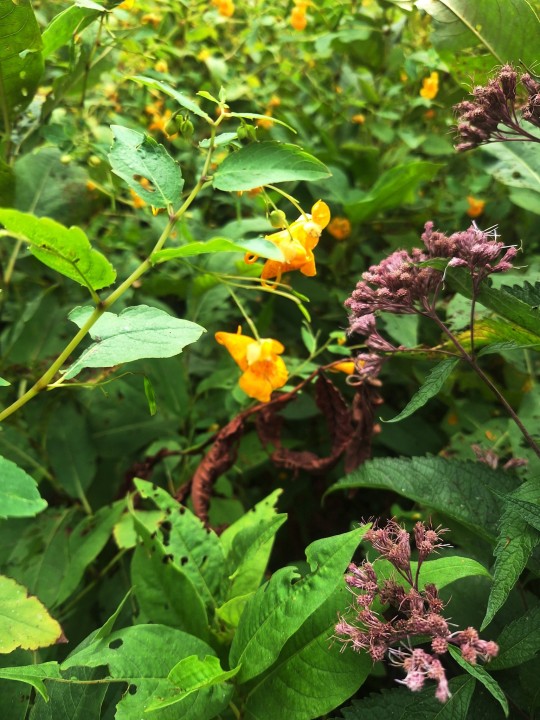
Jewelweed/Spotted touch-me-not, Joe-Pyeweed.
Sadly, the touch-me-not was already done for the year and didn't ploop out any of her seeds when I gave her a pet. Missd it!
8 notes
·
View notes
Text
Follyglass : Mists
We didn’t know how long we had been driving. That’s how being lost goes. As a matter of fact, I couldn’t remember starting the trip, but as I tried to think about it, as the question scratched in my head, you brightened and said “There, the house of the golden mists.”
Indeed, the mists gift us with beauty, but only in fuzzy pieces and delicate watercolor washes: a widow’s walk hovered in cloud, the twinkling shade in the arch of the old forest.
We were walking an allee of wrought oaks that lead us to the house- I didn’t remember getting out of the car- and you insisted we go left ‘”deosil” you said. “It’s how we get to the door”. But I could see the door just up the rise. Somehow your urge felt right as…..
In the cool shadow of the house, there was a lilypond. The gold-spotted frogs, of which there are many, guide our steps across the lily pads so we didn’t fall in and become lilyflowers ourselves. Nobody says this, we just know.
It would be a terrible beautiful fate, we thought.
Our toes did end up getting wet, but you assured me that is part of the plan, as we can only walk under the night dark path of wisteria bought without getting lost. When our feet have been blessed with lily water, the wisteria will kiss blessings upon our heads instead of turning us the wrong way in the night.
Beyond the night dark tunnel, jewelweed pressed against the path, and from there we could see the widow’s walk atop the house. Lord Cardinal paced and scaned the horizon for his love. There wasn’t an ocean for three days’ walk from here, but white snap sails could bee seen skimming the treetops of the surrounding woods.
“Don’t stare” you said as you hurried us along “and don’t look in the windows.”
But I’ve already seen the pale souls pressed against the glass. They wore fine old things. They stared at the black swans on the northern lawn, the black swans that danced among the clover. It seemed a magic dance, a binding by way of quadrille.
We rounded the northern corner of the house, and are at last to the door, you gestured that I should press the button. A flight of butterfly chimes alighted a melody.
From beyond the oaks and greengold field leapt a red deer; the steward of the house. She didn’t seem to be scared of us, of you, or of our dog with clear eyes and paws white as small daisies.
“Have you brought the nasturtium invitation” the deer asked.
I don’t know if we did.
I can’t even remember how we came to the house of golden mists..
…...
Inspired by true events on a summer morning at The Codman Estate
9 notes
·
View notes
Photo

Spotted Touch-Me-Not, Spotted Jewelweed
Impatiens capensis
Balsaminaceae (Jewelweed)
Photograph taken on October 11, 2021, at Rattray Marsh Conservation Area, Mississauga, Ontario, Canada.
11 notes
·
View notes
Note
(For the ask game) Dalmatian ?
His name is Dewey (which came about because spotted touch-me-not is one of my favorite plants, but touch-me-not is a bad name and Jewelweed - while lovely - would inevitably be shortened to Jewel (too girly) or weed (obvious problems). I've always been told it's called jewelweed because of how the dew gathers on it like little jewels so Dew -> Dewey). Anyway, this is a dog I'm definitely overwhelmed by until we figure out how to work together. They're bred for barking and running and my family is not a particularly big fan of either. We'll probably try bikejoring or something similar to try to meet his needs. Once he matures, he settles well into the role of family hiking dog with an agility hobby but 1-3 years is a rough time for us with some patches of reactivity. While we're not particularly competitive in agility, everyone recognizes us & we have several friends we keep running into there.
1 note
·
View note
Text
Teaching Learners: My Experience Learning How to be a Nature Interpreter
I am a visual and tactile learner, I enjoy seeing how things work and why things are as they are in real-time. For example, my work at the Outdoor School introduced me to one of my favourite plants, Jewelweed. When I was first introduced to Jewelweed, it was explained to me that it was a friend in the forest. It is named Jewelweed for the way it glistens in the rain, and nicknamed a 'touch-me-not' for the way the seed pods burst when brushed. It was vital for me to know and recognize because it could help soothe poison ivy rashes and bug bites. However, when I was told this, it was winter. The plants were covered with snow, there were no bugs to be concerned about or seed pods to pop.
When summer programming started, new kids arrived at the forest with different levels of personal connection and comfort with nature. My most memorable moment of nature connection came from a rough situation. A 10-year-old boy came to programming in one of the last weeks of summer. On a wander to a nearby creek, he went to explore up a hill and, unfortunately, stepped on a ground wasp nest. He came running back, screaming that he had been bitten by wasps. The bites were already growing and he was becoming paranoid that the wasps were following him. We ran back to camp together to get some water and cool down. I told him I knew just the thing that would help, Jewelweed. Together we crushed up the stems and talked about ways Jewelweed could be used to help itching and pain, how its leaves glimmer in the mist and its bright orange flowers that can be spotted from far away.
When he reunited with the group he took it upon himself to show them how he was able to feel better. He led them to a patch of Jewelweed and they all listened as he explained that the stems are more helpful than leaves at soothing, and how they are capable of magically gleaming.
Through this story, each aspect can connect to the stages of flow learning by Joseph Cornell (Beck et al. 2018). The first stage is awakening enthusiasm, by encouraging teamwork between the boy and I to help him, he was excited to go and look for the Jewelweed with me (Beck et al. 2018). Secondly, is focusing attention. I described to him how to use and crush the stems and mindfully and respectfully forage to protect the forest (Beck et al. 2018). The third stage is direct experience, the moment he felt pain relief from the Jewelweed, he was able to trust not only me but the land he was on to help him (Beck et al. 2018). The final step is sharing inspiration, when he told the group his own experience, they were able to bond as a group and collectively understand the power of the land around them (Beck et al. 2018).
The nature interpreter I want to combine all these stages and ensures a genuine, authentic, memorable connection to the outdoors. I've attached an image of some Jewelweed below! (Courtesy of Wikimedia Commons) For those interested, the leaves are hydrophobic so water beads rest on top and look like small gems :)

Reference:
Beck, L., Cable, T.T., & Knudson, D.M. (2018). Interpreting Cultural and Natural Heritage for a Better World. Sagamore Publishing.
4 notes
·
View notes